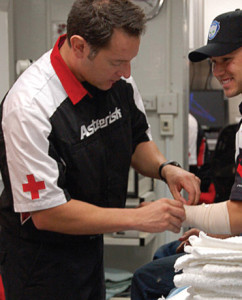
With high school athletes accounting for an estimated 2 million injuries each year, south Charlotte parents of high school student-athletes can rest easily knowing their children attend “safe sports” schools.
The National Athletic Trainers’ Association (NATA) announced 19 Charlotte-Mecklenburg high schools, with North Carolina High School Athletic Association athletic programs, received the Safe Sports School Award, and some south Charlotte high schools made the mark.
Ardrey Kell, South Mecklenburg, East Mecklenburg, Myers Park and Providence high schools earned the award, which recognizes the importance of providing the best level of care, injury prevention and treatment.
“This award recognizes the contributions and commitment of schools across the country that are implementing safe sports policies and best practices to ensure athletes can do what they love best and have the appropriate care in place to prevent, manage and treat injuries should they occur,” NATA President Scott Sailor said.
The award was launched in March 2013 as part of the Secondary School Athletic Trainers Committee of the NATA. Schools pay a $150 fee and apply for the award on an ongoing basis.
“The school must have a comprehensive athletic health care plan, promote safe and appropriate environments, provide proper sporting equipment, develop injury intervention strategies, rehearse an emergency action plan and promote a culture of safe play,” said Ellen Satlof, NATA public relations manager.
The U.S. Centers of Disease Control reported organized sports are on the rise, with nearly 30 million adolescents participating in youth sports in the U.S.
“There has been an increase in competitive sports, which are, unfortunately, not without risk. Brain injury/concussion, cardiac arrest, heat stroke, cervical spine fractures and other injuries and illnesses are potentially life-threatening,” former NATA president Jim Thornton said in a news release.
CMS partnered with Carolinas HealthCare System (CHCS) in 2011 to provide certified athletic trainers and help bridge the gap between health care providers and student-athletes in response to a growing concern nationwide about injuries among student-athletes, particularly concussions and cardiac deaths.
High school athletes account for an estimated 500,000 doctors visits and 30,000 hospitalizations each year, according to a study conducted by doctors and certified athletic trainers John Powell and Kim Barber-Foss.
“CMS values our longstanding partnership with Carolinas Healthcare System. The NATA Safe Sports School First Team Award achieved by our high schools is due in large part to our partnership with Carolinas HealthCare and the effort of athletic directors and athletic trainers in each school,” Susan Doran, CMS athletic director, said in the release. “We’re committed to providing quality care for our student-athletes, as well as a safe environment for them and their families. This award recognizes a standard of care provided to our student-athletes that ultimately improves their ability to perform at their highest level and enhances the environment in which they compete.”
Kevin Hinson, athletics director at South Meck, said the partnership has been a “load off of him” to ensure the safety of his student-athletes.
South Meck was one of the first four schools to receive a CHCS athletic trainer and Hinson said it’s made a big difference. Previously, schools would have to find a sports medicine teacher, who also was a certified athletic trainer, to head the departments’ athletic training, which Hinson said could be difficult to find.
“Having (CHCS) as a partner has been really huge for all schools so that we have an equal availability,” he added. “There is always a risk with athletics and to know that we have somebody qualified, who is really good with communicating with the parents, makes a difference.”
Brian Knab, athletics director at Ardrey Kell, said the school, which has more student-athletes than Queens University of Charlotte, would not be able to ensure the safety of its athletes without the athletic trainers in place.
He said Jacqui Frithsen, the school’s head athletic trainer, helps athletes even before practices with preventative care.
Leigh Ann Caldwell, manager of sports medicine with CHCS, believes some parents might not realize all athletic trainers’ tasks and the qualifications needed to take on the role.
“Athletic trainers are education and trained to recognize evaluate and treat injuries,” Caldwell said. “That’s what they go to school for.”
She explained an athletic trainer must attend a four-year program at an accredited university, pass a national board exam and obtain a state license.
“This is not something you can get over the Internet in 30 minutes,” Caldwell added. “It’s an incredible background and experience.”
All Charlotte-Mecklenburg high schools have a Carolinas HealthCare System-certified athletic trainers that work with the school year round
“It’s great recognition for CMS to show their parents, athletes and families that (the athletic trainers) put the care and health of their student-athletes first,” Caldwell said.